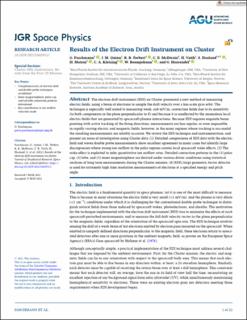| dc.contributor.author | Paschmann, G | |
| dc.contributor.author | Quinn, Jack M. | |
| dc.contributor.author | Torbert, R.B. | |
| dc.contributor.author | McIllwain, C | |
| dc.contributor.author | Vaith, H | |
| dc.contributor.author | Haaland, S. | |
| dc.contributor.author | Matsui, Hiroshi | |
| dc.contributor.author | Kletzing, Craig A. | |
| dc.contributor.author | Baumjohann, W | |
| dc.contributor.author | Haerendel, G | |
| dc.date.accessioned | 2022-01-24T07:40:16Z | |
| dc.date.available | 2022-01-24T07:40:16Z | |
| dc.date.created | 2021-08-02T12:46:15Z | |
| dc.date.issued | 2021 | |
| dc.identifier.issn | 2169-9380 | |
| dc.identifier.uri | https://hdl.handle.net/11250/2838813 | |
| dc.description.abstract | The electron drift instrument (EDI) on Cluster pioneered a new method of measuring electric fields, using a beam of electrons to sample the drift velocity over a km-scale gyro orbit. The technique is especially well suited to measuring weak, sub-mV/m, convection fields due to its sensitivity (to both components in the plane perpendicular to B) and because it is unaffected by the anomalous local electric fields that are generated by spacecraft-plasma interactions. Because EDI requires exquisite beam pointing with active tracking of the firing directions, measurements are less regular, or even impossible, in rapidly varying electric and magnetic fields; however, in the many regimes where tracking is successful the resulting measurements are reliably accurate. We review the EDI technique and instrumentation, and present six areas of investigation using Cluster data: (1) Detailed comparisons of EDI data with the electric field and waves double probe measurements show excellent agreement in many cases but identify large discrepancies where strong ion outflow in the polar regions creates local spacecraft wake effects. (2) The wake effect is exploited to infer quantitative ion outflow rates. Detailed convection patterns in the (3) polar cap, (4) lobe, and (5) inner magnetosphere are derived under various driver conditions using statistical analyses of long term measurements during the Cluster mission. (6) EDI's large geometric-factor detector is used for extremely high time resolution measurements of electrons at a specified energy and pitch angle. | en_US |
| dc.language.iso | eng | en_US |
| dc.publisher | Wiley | en_US |
| dc.rights | Attribution-NonCommercial-NoDerivatives 4.0 Internasjonal | * |
| dc.rights.uri | http://creativecommons.org/licenses/by-nc-nd/4.0/deed.no | * |
| dc.title | Results of the Electron Drift Instrument on Cluster | en_US |
| dc.type | Journal article | en_US |
| dc.type | Peer reviewed | en_US |
| dc.description.version | publishedVersion | en_US |
| dc.rights.holder | Copyright 2021. The Authors | en_US |
| dc.source.articlenumber | e2021JA029313 | en_US |
| cristin.ispublished | true | |
| cristin.fulltext | original | |
| cristin.qualitycode | 2 | |
| dc.identifier.doi | 10.1029/2021JA029313 | |
| dc.identifier.cristin | 1923410 | |
| dc.source.journal | Journal of Geophysical Research (JGR): Space Physics | en_US |
| dc.relation.project | Norges forskningsråd: 223252 | en_US |
| dc.identifier.citation | Journal of Geophysical Research: Space Physics. 2021, 126 (6), e2021JA029313. | en_US |
| dc.source.volume | 126 | en_US |
| dc.source.issue | 6 | en_US |

